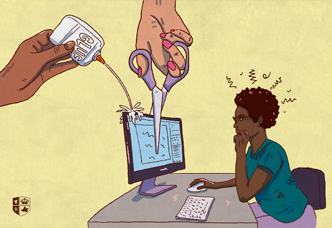5 Signs That You Need a Design Team
Business owners have a plethora of decisions to make on a daily basis. Many of these decisions require an owner to weigh the cost vs. benefit of a vendor, hire or service. Marketing and design is the multi-faceted monster that everyone knows they need but most think they cannot or should not afford.

A “design team” can be found in all shapes and sizes, but ultimately their job is to move clients forward through strategic and creative thinking. At BatesMeron, our design team is only one part of what makes us tick; we also have copywriters, project managers, account managers and creative directors that collaborate to develop thoughtful marketing pieces that deliver results.
As such, here are five clear signs that you need to work with a design team in order to advance your business:
1. You’re designing things yourself.
Unless you’re running a design firm of your own or the word “designer” is somewhere on your business card, it’s time to take a step back and reevaluate your position. While startups and small businesses tend to value those who can “wear many hats” (the profitability and viability of this mindset aside), there are many things SMBs can do on their own. Design is not one of them.
2. You cannot tell the difference between good design and bad design.
Good design serves a brand and business by setting it apart, breaking it through the clutter of its competition and consistently pulling its elements through all touch points with your target audience. Good design showcases brand pride, emotes business longevity, fixates the consumer and paves the path of consistency across the mental bridge from engagement to purchase.
Bad design either breaks through the clutter in unfortunate ways that hinder success, or worse: goes unnoticed into the void. Bad design curses a brand with an air of the temporary, undependable and unkempt. Bad design inconsistently and haphazardly distracts from the purpose of the medium. For example: a badly designed brochure can be so cluttered, poorly organized or illegible that it fails to convey the intended information. That’s a costly and disheartening mistake.
Note: There is nothing wrong with not knowing the difference between good and bad design. This is yet another reason why branding and design professionals exist. It is not realistic to expect to be a master of all domains. Defer to the experts when necessary.

3. Your materials are client-facing.
Your business’s marketing materials include: website, letterhead, business card, flyers, posters, advertisements (online and traditional), sales sheets, PowerPoint presentations and a hundred other things. These items make important visual impressions on your clients, colleagues, prospects and competitors; therefore it is important that they are professional, consistent and reflective of your brand.
If you allocate the time, effort and resources to provide excellence in your business’s goods or services, why wouldn’t you give the same credence to the way in which you show it off to prospects? If you expect others to believe in your product enough to purchase it, you must look the part.
4. A friend/relative/coworker is designing your company’s materials.
Your friend is not a designer. She may make nicer-looking things than you could or would have time to make for yourself, but unless she is in the business of marketing design, her efforts are only a partial, temporary patch. And I guarantee that patch is ill-placed, as it was not fixated on a goal and serves no overarching strategy to improve your business.
Your intern is a marketing intern. Not a designer. Interns should be working in their area of study, not making your company a brochure. Your coworker is an office manager. Not a designer. Your buddy/pal/friend/bro is an (insert random profession here). Not a designer. There’s a running theme here.
Yes, there is a difference. Designers are professionals who have been trained specifically to apply art to problem-solving. They are the visual communicators of the marketing mix and they do far more than “make things look and sound nice.”
Effective marketing design is less aesthetic and more purpose-bound.
Quick tip: ask the designer you’re considering about the software they use for designing. A glaring red flag is when they say “Photoshop” or if they have no design software at all. Design software is expensive because it produces professional-grade work and is therefore absolutely necessary. Beware of the “designer” working in Microsoft Paint or Corel Draw.
5. You get what you pay for.
Many times, even that friend or family member who does have a design background is a bad option for a business—especially if that person is asked to do the job at a reduced rate. The rule is simple: anything less than professional pay for professional work is often a recipe for a sub-par outcome. This applies to more than just design work.
The bottom-line for your business is that the ROI of good design comes in the form of higher price points, heightened reputation, increased awareness and long-term trust from a team that knows how to take care of your brand. That’s what makes it worthwhile.

The truth is harsh. If you aren’t a designer, you usually have no business designing. Excellent marketing design is the child of a perfect marriage between art and science, resulting in the advancement of your brand and the growth of your business.
Full disclosure: I am not a designer. In fact, not only am I guilty of many of the items on this list, but even my stick-man drawings are among the worst you’d ever see. I am a connector and deal-maker. But I am fortunate to be surrounded by some of the very best talent I’ve ever seen. And every single piece of my agency-mates’ design and copy serves a specific, strategic, business marketing goal. Does yours?
Manage Change Management with Marketing
Will Letter for Lunch
Microsoft's (Anti)Viral Secret










